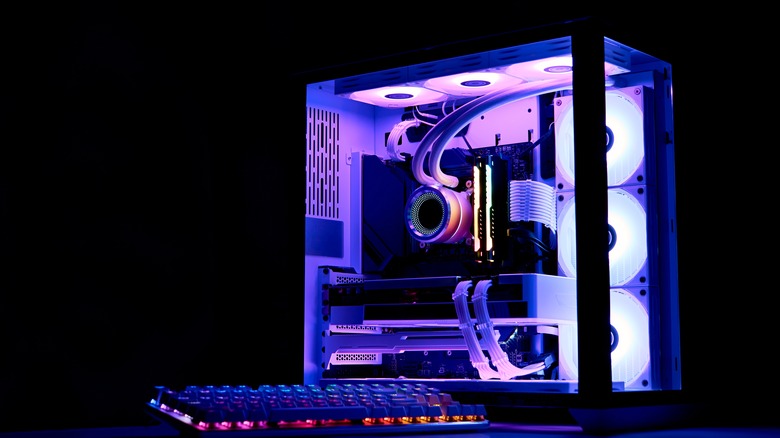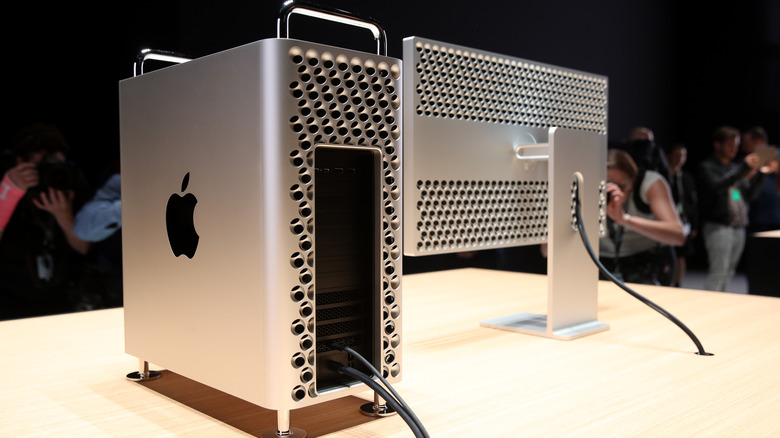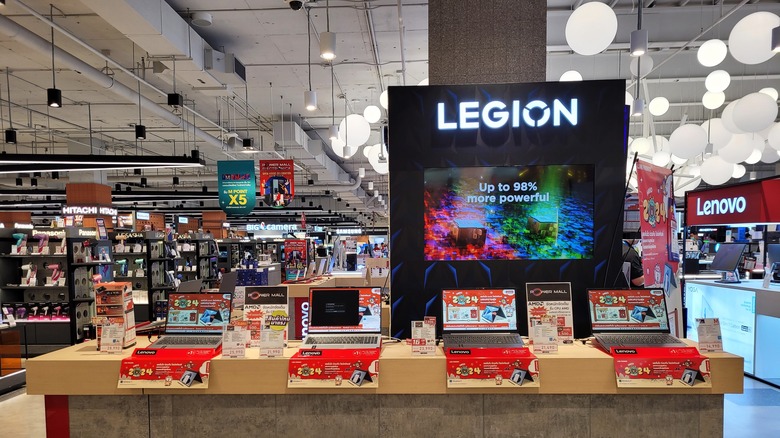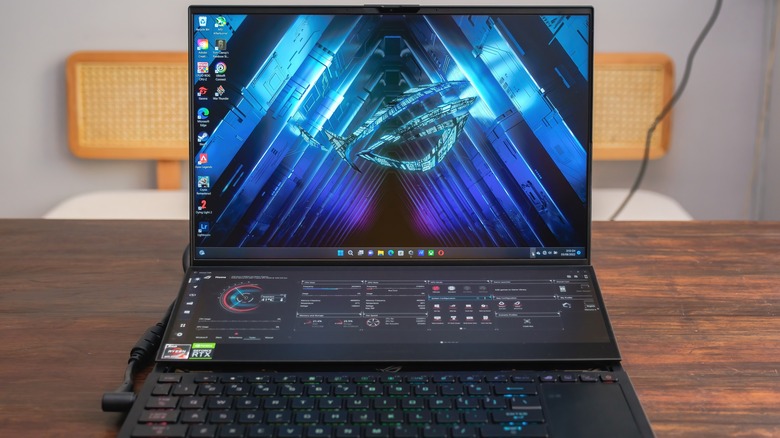
Om.Nom.Nom/Shutterstock
Computers are some of the most versatile and powerful devices you might find in a home, especially when they’re built with up-to-date hardware. With the advent of ray tracing graphics cards and widespread improvements to AI, building your own computer has never before led to such incredible potential. Of course, it’s also become far more of a risk as a result. There may not be a lot of people out there who would be comfortable enough to personally handle a thousand-dollar computer component, even if they’ve built a desktop PC before.
If the task of building your own computer simply isn’t worth the risk — even with a budget that spares no expense — you might be more interested in checking out pre-built systems. Many well-known names have taken the initiative to include the most powerful components out there, which also leads to some of these systems getting price cuts and sales over time. As a result, getting these pre-built computers can sometimes be far more convenient and cheaper. If you’re the type of person to welcome this idea, you might want to know about the most powerful pre-built computers available from every major brand today.
HP
HP is among the most well-known manufacturers of pre-built computers. As a result, one of its most powerful products — the HP Omen 45L — has some of the greatest high-end components out there. The incredibly powerful RTX 4090 enables it to run any graphics-intensive software with ease, even with its Intel i9 processor only being from the 13th generation, rather than the latest 14th. It also falls a bit flat in the area of RAM, only having 16 GB available, but its unique liquid cooler and 1200-watt power supply make up for this shortcoming with great future-proofing — as it should with a price point of over $3,000.
One thing to be wary of regarding the 45L is how closely tied it is to HP itself. In other words, you might find that the proprietary parts aren’t so great in the long run, and you should expect plenty of bloatware when you boot the system up for the first time. The storage space is also somewhat lacking, with 2 TB being split between an HDD and an SSD, so consider making some upgrades to the storage and RAM if you eventually need to.
If you’re more interested in a workstation rather than a gaming device, you’ll find greater results with the HP Z8 Fury. These computers can reach prices of $6,000 or more, and in return, they’re able to include Intel’s Xeon W processors and Nvidia’s RTX A4000 graphics cards. These focused components will be more useful for professional tasks in the long run, though the Omen is still a better buy for gaming enthusiasts.
Apple

Justin Sullivan/Getty Images
To the surprise of not one single Apple fan, the Mac Pro is the company’s most powerful computer out there. Thanks to its specialized CPU and GPU, there aren’t many other computers out there that can compete with it when it comes to content creation and artwork. Due to being a tower, its PCIe capabilities also allow the Mac Pro to serve up big expandability, giving users the chance to add more storage or I/O slots. From a simple look at the numbers, it’s hard not to be impressed by what the Mac Pro offers.
Of course, with the Mac Pro being a Mac, there aren’t many options for upgradability outside of the aforementioned PCIe slots and whatever else Apple offers. Don’t expect fantastic gaming performance even if you install Windows or rely on natively-supported titles. It can still pull its own weight in that area, but at a price of $7,000 or more, the use cases for it are definitely far more niche than more common or comparatively affordable high-end computers.
Dell
Thanks to its Alienware brand, Dell is able to offer special gaming promotions for anyone buying their hardware, from in-game items to brand-new titles. This would be meaningless if the hardware couldn’t support those titles in the first place, but the Aurora R16 is more than ready for anything you could throw at it. Between the RTX 4090, 14th-gen Intel i9 processor, 64 GB of RAM, and even a 4 TB SSD, the R16 seeks to be the last computer you’ll ever need. The price requires a similar level of commitment at almost $5,000 — even without any of the extra software options — but the performance will likely make the cost worthwhile for die-hard enthusiasts.
Like HP, Dell suffers from heavy use of unique components and pre-installed software. While these are meant to make first-time experiences more manageable, they can also lead to performance issues thanks to a lack of airflow and internal resource use. Dell computers are also notoriously difficult to upgrade, so if you want to keep this machine around even after its top-end components are long past their prime, you’re better off looking somewhere else.
For workstations, Dell also offers the Precision 7960 Rack. These are optimized for AI development and offer numerous configurations, including multiple CPUs and graphics cards. Going with the most expensive setup which will cost you upwards of $250,000 or more, making it quite possibly the most expensive item on this article. It’s up to you whether you think that price point is worth it, but the Precision 7960 definitely deserves to be mentioned as one of the most powerful computers out there.
Lenovo

Opasbbb/Shutterstock
Lenovo has a pretty wide range of options when it comes to powerful computers. The Legion Pro 7i is one of the few laptops to feature in this article, priced at around $3,649, and boasting an Intel i9 14900HX and an RTX 4090 — enough to compete even against some high-end desktops, despite being a mobile version of the GPU. For those who don’t want the upgrade restrictions of a laptop, the Legion Tower 7i would be the way to go. Unfortunately, despite its similar processor, it only manages to include an RTX 4080 Super, rather than a 4090, despite being more powerful. An alternate tower with a slightly lesser processor and better graphics card is part of Lenovo’s offerings, but isn’t currently available.
As usual, those looking for workstations have other options thanks to Lenovo’s ThinkStation PX. At the highest price point, this device has an Intel Xeon Gold 5420+ processor and an Nvidia RTX A5500, on top of 256 GB of RAM and 4 TB of SSD storage. This combination of components is even able to blow previously-mentioned workstations out of the water entirely, and it certainly should at a price of almost $15,000.
Asus

tinhkhuong/Shutterstock
Rather than having a selection of prebuilt desktops, Asus provides extensive laptop options for performance-seeking enthusiasts. There are three major options to pick from, all of them priced at around $3,000 thanks to including the mobile version of the top-of-the-line RTX 4090. Additionally, the ROG Strix Scar 18 offers an Intel 14900HX, while the Scar 17 X3D — an upgrade to the previous Asus ROG Strix Scar 17 — boasts an AMD Ryzen 9 7945HX3D, with both processors trading blows in benchmarking software and gaming performance. There’s also the Zephyrus Duo, which only offers a slightly weaker AMD processor, but has extra features, including a second built-in display.
The ProArt Station PD5 PD500TE is the choice for creative users here, but it doesn’t offer much that previous workstations couldn’t already provide. It’s only able to reach up to Intel’s 13th generation of processors and Nvidia’s RTX A4000 graphics card, even the gaming laptops could theoretically outperform it in various tasks. You should take a look at the installed software and the mobile versions of the CPUs and GPUs on these laptops first, though, as the pre-installed software for measuring performance and controlling RGB lighting can do a number on their batteries and thermals.
Acer
Starting with Acer, options for powerful computers become a lot more limited. The company doesn’t have very many solutions for workstations, leaving buyers stuck with gaming options. One of its most powerful products is the Predator Helios 18, a gaming laptop boosted by Acer for 2024, priced at just above $3,000.
Acer’s laptop includes the 14900HX as well as the RTX 4090, so there’s not a whole lot here that you won’t find from other high-end gaming laptops. Notably, it manages to be almost $1,000 cheaper than the Predator Helios 3D 15 SpatialLabs Edition, which has a weaker CPU and GPU. This alternate choice does manage to provide more RAM and a better 4K display, but it doesn’t change how well the device can actually handle such a display, putting the Helios 18 on top.
When it comes to towers, the Predator Orion 7000 is quite obviously the most powerful of the bunch. It comes with all the high-end essentials like the Intel i9 14900KF and RTX 4090, but most of its parts — from the cooler to the motherboard — are still very proprietary. Combine that with a price tag of $4,499, and you’re paying a hefty sum for a computer that might have trouble keeping itself cool under heavy loads. There’s also the alternative choice of the Predator Orion X, which can provide similar performance in a much smaller form factor. It’s not available in the United States at the moment, but if that’s not an issue for you, it might be worth considering alongside the 7000.
Microsoft
Similarly to its rival OS developer, Microsoft only really has one professional-focused option as its most powerful computer. This option is the Surface Studio 2+, which — despite its $4,499 price — only has an 11th gen Intel CPU and an RTX 3060. In terms of power, this device simply doesn’t have a whole lot backing it up, and its status as an all-in-one makes upgrading difficult at best, and impossible at worst. If you’re looking for the strongest computer out there, this simply isn’t going to satisfy you.
On a more positive note, the Surface Studio 2+ boasts features that even more powerful computers can’t offer on their own. Between the incredibly high-res 4500×3000 display with touch capabilities and the included Zero Gravity Hinge, this computer still manages to be very versatile for constantly-moving users. While it lacks speed and performance from other devices, the Surface Studio 2+ is nearly unmatched when it comes to having a powerful display.
MSI
MSI has a fairly wide selection of high-powered gaming computers, including its Titan 18 HX laptop and Vision Elite RS 14th desktop. Both of these are loaded with the 14th-gen Intel i9, as well as the RTX 4090, with the laptop offering different resolutions and the desktop having a 360mm liquid cooler installed. The desktop also includes a specialized MSI graphics card with its own custom cooling system and fine-tuned performance. Its pricing can be a little daunting at over $5,000 for the laptop and over $4,000 for the desktop, but the overall performance of this beast is sure to be unparalleled against other pre-built PCs with similar specs.
One desktop in particular that deserves to be mentioned is the Infinite RS 14th. Though it lacks the nice-looking case of the Vision Elite RS, it contains a liquid-cooled variant of the 4090 with practically no changes to the rest of its specs. Its price even manages to cut just under $4,000 in spite of this. It’s still an expensive option, but the Infinite RS 14th is a prime example of how a higher price point doesn’t always mean a more powerful system.
Samsung
Though Samsung is one of the biggest leaders in the tech industry, its own selection of computers is somewhat lacking for the most demanding tasks. The most powerful device it offers in this area is the Galaxy Book4 Ultra, and its most powerful features are more related to the screen and software. A 3K AMOLED display is an incredible addition to any device, and the personalized AI assistance should help you feel like you’re truly living in the modern era. Unfortunately, when it comes to hardware, it just can’t stand up to stronger competitors very well.
While the included «Ultra» Intel processor is still impressive, it falls flat of the 14900’s performance in both desktops and laptops. Additionally, the best GPU that’s able to be put into the Book4 Ultra is simply an RTX 4070, which — while still impressive in its own right — is a far cry from the powerhouse of the 4090 mobile GPU. At a price of around $3,000 for this setup, you’re paying more for the screen and software than for the power of its components. If speed is what you’re after, the Book4 Ultra is far from your best choice.
Razer
Razer is another company that focuses more on laptops to provide powerhouse components to. While the company offered gaming desktops with the help of Maingear, these don’t seem to be available anymore. Regardless, your best choice from this company will be the Razer Blade 18. As usual, it includes the 14th-gen i9 and 4090, but there’s even more to this laptop than the power hidden inside it.
The Razer Blade 18 truly takes advantage of being a laptop thanks to its incredible display. A 300 Hz mini-LED monitor is rare even for desktops, and to combine that with 4K compatibility at 200 Hz is almost unheard of. The laptop has also been pre-customized to push as much power out of its GPU as possible, ensuring it will be fast no matter what. Even if it doesn’t quite manage to match the speed of other devices, the extra hardware benefits will help make the Razer Blade 18 feel like the most powerful computer you can get.
Corsair
Corsair’s most powerful computers are the Vengeance gaming desktops, but once again, the choice might not be as simple as picking the higher-priced one. The lower-numbered a8100 boasts an AMD Ryzen 9 7950X3D with 64 GB of RAM at 5600MT/s, while the i8200 holds an Intel i9 14900KS and 64 GB of RAM at 6400MT/s. Both towers also have slightly different cooler designs, but the actual performance of the coolers are unlikely to change between the two. These are the only major differences between each Corsair Vengeance desktop … outside of price, of course.
The two CPUs in each Vengeance desktop are extremely powerful on their own, offering very competitive numbers in terms of both productivity and gaming. But the a8100 is cheaper by at least $400, with the only major hit in performance being directed towards RAM speed. 64 gigabytes of DDR5 RAM is going to be effective for most users no matter what, so unless you really need an Intel CPU rather than an AMD one, there isn’t much reason to go for the i8200 over its cheaper counterpart.
CyberPowerPC
CyberPowerPC is among the best Custom Gaming PC Builders out there, and as a result, it can be somewhat tricky to pinpoint their most powerful computer. In terms of non-customizable pre-built PCs, the company’s $3,400 GLX 99613 stands out above the rest. It’s the only one to have the 14th-gen Intel i9 and RTX 4090 components found in most high-end gaming PCs. However, through the website’s custom builder, it’s remarkably easy to get similar or even stronger setups with even more freedom over components like coolers and graphics card variants.
One particularly noteworthy offering from CyberPowerPC is its AMD Threadripper Ultimate. At a starting price of around $10,000 — and reaching even higher with certain custom selections — this PC provides insane power for professional work of all kinds. Its CPU will almost certainly fall short in gaming compared to the cheaper pre-built option, but for everything else, the Threadripper will go far above and beyond what most other computers could offer. With the extra customization options, CyberPowerPC is an attractive choice for anyone looking to get as much power as possible.
iBuyPower
Rounding out this list of high-end computer brands is iBuyPower, offering its own selection of pre-built PCs with unique cases and fans. Though it’s currently out of stock, the company’s most powerful pre-built PC is the RDY Element Hybrid Max III. On top of the i9 14900KF CPU, it also has the same liquid-cooled GPU boasted by MSI’s Infinite RS 14th. The included parts are actually combinations of components from Corsair, Asus, and other companies. Considering how no software-related components are proprietary, you can rest easy knowing that future upgrades for this system will be exceedingly simple compared to those from companies like Dell or HP.
As usual, the most glaring issue with this build is the price, set at just under $5,000. This is in line with previously mentioned high-end computers, but if you were to build this exact PC yourself, it would hardly cost more than a total of $3,600. Pre-built computers can remove a lot of the risk from building your own system, and in some cases, they manage to be even cheaper thanks to flash sales. But with price differences of $1,000 or more, it’s not a bad idea to think a bit harder about taking that risk for yourself.
In the case of iBuyPower, the graphics card doesn’t even come pre-installed, so you’ll still have to prepare a screwdriver and poke around inside the system on your own.